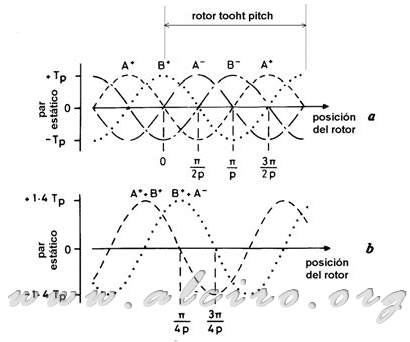2.1.3.2. Hybrid engines
In the hybrids have two phases that can be excited with positive or negative currents, if the motor winding is bifilar, it has four phases are excited with unipolar current. If each phase is excited with a full step sequence, four steps are implemented while the rotor moves one space of tooth (tooth pitch). Then the length of a step corresponds to a quarter of space tooth (tooth pitch), and four waves of static torque characteristics stationed at this distance, Figure 3.6 (a). The static torque characteristic for an active phase is approximated to the sine function:
 \\ T_{A-}\ =\ -T_p*sin(d*\theta -\pi ) \\ T_{B+}\ =\ -T_p*sin(d*\theta - \frac{\pi }{2})\\ T_{B-}\ =\ -T_p*sin(d*\theta - \frac{3*\pi }{2})) (3.6)
(3.6)
we have A + T is the torque on the rotor position Θ when phase A is excited by positive current.

Figure 3.6. Static torque characteristic curves for a hybrid of two phases. (A) Sequence of excitation of an active phase. (B) Sequence of excitation of two active phases.
The effect of simultaneously excite a couple of phases shown in Figure 3.6 (b). The peak static torque is increased by a factor of 1.4 with reference to the excitement of an active phase. For phases A and B excited with the positive current static torque is:
*cos(\frac{\pi }{4})\\ =\ -1.4*T_p*sin(p*\theta - \frac{\pi }{4})) (3.7)
(3.7)
and similar combinations with the other phases.







